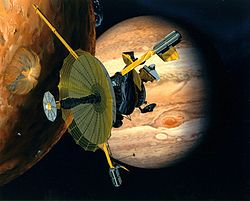
Back استكشاف آيو Arabic Exploration d'Io French Esplorazione di Io Italian Utforskning av Io NB Дослідження Іо Ukrainian

The exploration of Io, Jupiter's innermost Galilean and third-largest moon, began with its discovery in 1610 and continues today with Earth-based observations and visits by spacecraft to the Jupiter system. Italian astronomer Galileo Galilei was the first to record an observation of Io on January 8, 1610, though Simon Marius may have also observed Io at around the same time. During the 17th century, observations of Io and the other Galilean satellites helped with the measurement of longitude by map makers and surveyors, with validation of Kepler's Third Law of planetary motion, and with measurement of the speed of light.[1] Based on ephemerides produced by astronomer Giovanni Cassini and others, Pierre-Simon Laplace created a mathematical theory to explain the resonant orbits of three of Jupiter's moons, Io, Europa, and Ganymede.[1] This resonance was later found to have a profound effect on the geologies of these moons. Improved telescope technology in the late 19th and 20th centuries allowed astronomers to resolve large-scale surface features on Io as well as to estimate its diameter and mass.
The advent of uncrewed spaceflight in the 1950s and 1960s provided an opportunity to observe Io up-close. In the 1960s the moon's effect on Jupiter's magnetic field was discovered.[1] The flybys of the two Pioneer probes, Pioneer 10 and 11 in 1973 and 1974, provided the first accurate measurement of Io's mass and size. Data from the Pioneers also revealed an intense belt of radiation near Io and suggested the presence of an atmosphere.[1] In 1979, the two Voyager spacecraft flew through the Jupiter system. Voyager 1, during its encounter in March 1979, observed active volcanism on Io for the first time and mapped its surface in great detail, particularly the side that faces Jupiter. The Voyagers observed the Io plasma torus and Io's sulfur dioxide (SO
2) atmosphere for the first time.[1] NASA launched the Galileo spacecraft in 1989, which entered Jupiter's orbit in December 1995. Galileo allowed detailed study of both the planet and its satellites, including six flybys of Io between late 1999 and early 2002 that provided high-resolution images and spectra of Io's surface, confirming the presence of high-temperature silicate volcanism on Io. Distant observations by Galileo allowed planetary scientists to study changes on the surface that resulted from the moon's active volcanism.[2]
In 2016, Juno arrived at Jupiter, and while the mission was designed to study Jupiter’s atmosphere and interior, it has performed several distant observations of Io using its visible-light telescope, JunoCAM, and its near-infrared spectrometer and imager, JIRAM.[3]
NASA and the European Space Agency (ESA) have made plans to return to the Jupiter system in the 2020s. ESA launched the Jupiter Icy Moon Explorer (Juice) to explore Ganymede, Europa, and Callisto in 2023, while NASA launched the Europa Clipper in 2024. Both will arrive in the Jupiter system in the late 2020s and early 2030s and should be able to acquire distant observations of Io. The proposed NASA Discovery mission Io Volcano Observer, currently going through a competitive process to be selected, would explore Io as its primary mission.[4][5] In the meantime, Io continues to be observed by the Hubble Space Telescope as well as by Earth-based astronomers using improved telescopes such as Keck and the European Southern Observatory.[6]
- ^ a b c d e Cite error: The named reference
IobookChap2was invoked but never defined (see the help page). - ^ Cite error: The named reference
IobookChap3was invoked but never defined (see the help page). - ^ Anderson, Paul Scott (January 6, 2019). "New Juno images of Io's fiery volcanoes". EarthSky. Retrieved February 14, 2020.
- ^ "NASA Selects Four Possible Missions to Study the Secrets of the Solar System". NASA. 13 Feb 2020.
- ^ McEwen, A. S. (24 August 2009). Io Volcano Observer (IVO) (PDF). Satellites panel of 2009 Decadal Survey. Archived from the original (PDF) on 2012-02-29. Retrieved 2010-02-20.
- ^ Cite error: The named reference
IobookChap12was invoked but never defined (see the help page).